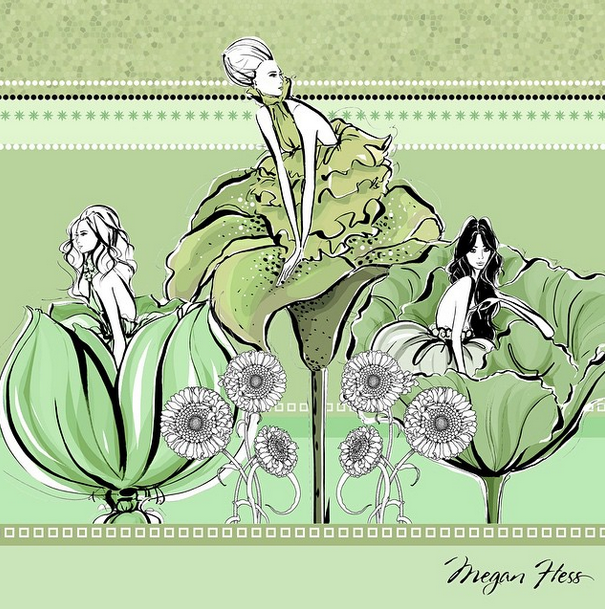Somewhere in the untamed French countryside near Versailles, on the border of all that was good and evil, once sat a small patch of wild lavender, and just beyond, a smaller spring. An accidental journey brought Astrid to this spring, its water tumbling like wet poetry across flowering earth.
She was in the shrubbiest part of the woods searching for a particularly large clump of jasmine to be tucked behind her sister Maryse’s “perfect pearl of an ear.” (This ear, according to their mother, Bernadette, was but a single feature among any number of flawless ones that could be found resting on the perfect face of Maryse.)
“As you get older, it’s actually quite the luck you look so much like your father,” said Bernadette on Astrid’s twenty-third birthday last year. “Unlike me or Maryse, you have no discernible beauty now, so you’ve no beauty to lose.”
Yet, even to the casual stranger, Astrid, like her father, was undeniably beautiful in both heart and head. Her beauty was a seedling of fact sowed through compliments like this from Monsieur Claude Duvet: “Well heavens awaken me, Astrid! You’ve become a woman worthy of the gods!”
Indeed she had, growing from pretty little Astrid into a honey-haired, indigo-eyed Aphrodite. Her mother and sister weren’t completely unattractive, each with some agreeable amount of beauty – Maryse an exact, younger reflection of her mother – though when standing by Astrid, the two couldn’t compare.
But here’s the logic of Bernadette the moderately beautiful philosopher: If she was, in her mind, a great beauty then so too was Maryse, sharing her mother’s rubberish complexion and brown, wiry hair. In lingering glances, it might be said Bernadette was more keenly aware of Astrid’s goddess-like looks than she let on.
A fair bet could be made then won that this knowledge motivated Bernadette to give Astrid an endless list of daily chores like picking flowers for her sister’s hair or sewing a dead dragonfly onto the collar of a twill dress.
“I’m only asking you to make me a bug brooch,” her mother had said. “Unless those fat fingers of yours have stopped working, I don’t see why it must be that hard.”
While Astrid was busy figuring out how to thread a dragonfly’s wing, Bernadette was dragging Maryse to every fête west of Paris, teacup-clanking a path through society’s ranks. “There is grave necessity for us to be seen in public,” her mother told Maryse. “We must wow those who matter through our stylish grace and be grateful for the sturdiness of Astrid; with your father gone, we can’t afford a mule.”
Astrid was on such a mulishly mandated chore – “collect a handful of lavender that’s turned a deep purple but hasn’t yet browned” – when she found the spring. She heard the burbles of the spring before she saw it, which explained why Astrid bumped into a woman standing at its edge.
“I’m so sorry, Madam!”
The woman looked up and Astrid stared right into her dark, feral eyes. She was almost a head shorter than Astrid, a bad hunch curling her back, a frizz of gray hair growing around a face crackled as an old pumice stone.
“It’s nothing,” the woman cooed. “Come closer though, these eyes can’t see like they used to and I need your help.”
With an agreeable head shake, Astrid took a step toward the curious woman near the spring.
“Better. But would you mind bringing me some water? I can’t reach down far enough.”
Astrid did as told, emptying her bucket of the lavender inside, sweeping it clean then scooping a handful of spring water.
“For you,” Astrid said. “Please keep the bucket so you can use it if you ever visit this spring again.”
The woman giggled and the sound was young and bright. “I do come most afternoons,” she replied. “Thank you for this gift, Astrid the Beautiful, and here is mine in return …”
How the woman knew her name or how in the next moment, Astrid was back in her kitchen, lavender in hand, should rightly be described as magic.
“Late again, Astrid!” Her mother growled, grabbing at the lavender. “Maryse, come come and let’s see if these flowers can be stuck to your little ear.”
“If the lavender doesn’t work, I can …” Astrid began but never finished. As she spoke, each word produced a tiny diamond from her mouth, which fell to the floor with a ceremonious and sparkly thud.
Bernadette, a matter-of-fact woman who believed intelligence the awful stepsister of charm, never thought to ask why diamonds were suddenly spurting from her youngest daughter’s mouth. She only wanted to know how such a thing might also happen for Maryse, “whose lips are so much prettier and more deserving of jewels.”
“I’m not sure,” Astrid said, three small diamonds springing free from somewhere behind her snow-white teeth. “When I was picking lavender, I met a woman who said she had a gift for me …”
“You met a woman with a gift for you?” Bernadette was practically cackling. “Of course she didn’t know of your sister, better in every way, otherwise … otherwise! Take Maryse to this woman directly so she can give her a diamond mouth and take yours away, if possible. Though the diamonds you’ve spilled, we’ll keep.”
When Astrid returned to the spring with Maryse, the woman was still there, a huddled fairy among lavender brush.
“That’s her,” Astrid whispered, nudging Maryse forward and catching the two diamonds that left her tongue. Astrid was sure none of what her mother wanted would come to pass; Maryse barely spoke to anyone but when she did, whatever came out was terrible.
“Hello, Madame!” Mayrse bellowed. “I would like a diamond mouth like my sister but brighter and with larger diamonds! I would also like! It! Right! Now!”
The woman never nodded or smiled to let Maryse know she’d heard the request. Instead, when Maryse said her last word – “now” – an enormous, slimy toad jumped from her mouth into the spring.
“What?” Maryse burped and another toad parted her lips, splashing as it hit the foamy surface of the spring.
Astrid, in her kind heart, almost felt sorry for Maryse. Still, watching the toads that dove happily from her sister’s screaming mouth into the water below, she had only one thought: escape. As Astrid walked away, she turned one last time toward the woman, a wonderful, gift-giving nymph of the woods, who if she could speak might tell you now and ever after that Astrid lived a happy life.
[The inspiration for this story cane from a drawing of the Versailles gardens by Megan Hess, famed fashion illustrator. You can see more of her work here. Also, read the original tale that this one was adapted from, written by Charles Perrault, who helped design the labyrinth of Versailles.]
She was in the shrubbiest part of the woods searching for a particularly large clump of jasmine to be tucked behind her sister Maryse’s “perfect pearl of an ear.” (This ear, according to their mother, Bernadette, was but a single feature among any number of flawless ones that could be found resting on the perfect face of Maryse.)
“As you get older, it’s actually quite the luck you look so much like your father,” said Bernadette on Astrid’s twenty-third birthday last year. “Unlike me or Maryse, you have no discernible beauty now, so you’ve no beauty to lose.”
Yet, even to the casual stranger, Astrid, like her father, was undeniably beautiful in both heart and head. Her beauty was a seedling of fact sowed through compliments like this from Monsieur Claude Duvet: “Well heavens awaken me, Astrid! You’ve become a woman worthy of the gods!”
Indeed she had, growing from pretty little Astrid into a honey-haired, indigo-eyed Aphrodite. Her mother and sister weren’t completely unattractive, each with some agreeable amount of beauty – Maryse an exact, younger reflection of her mother – though when standing by Astrid, the two couldn’t compare.
But here’s the logic of Bernadette the moderately beautiful philosopher: If she was, in her mind, a great beauty then so too was Maryse, sharing her mother’s rubberish complexion and brown, wiry hair. In lingering glances, it might be said Bernadette was more keenly aware of Astrid’s goddess-like looks than she let on.
A fair bet could be made then won that this knowledge motivated Bernadette to give Astrid an endless list of daily chores like picking flowers for her sister’s hair or sewing a dead dragonfly onto the collar of a twill dress.
“I’m only asking you to make me a bug brooch,” her mother had said. “Unless those fat fingers of yours have stopped working, I don’t see why it must be that hard.”
While Astrid was busy figuring out how to thread a dragonfly’s wing, Bernadette was dragging Maryse to every fête west of Paris, teacup-clanking a path through society’s ranks. “There is grave necessity for us to be seen in public,” her mother told Maryse. “We must wow those who matter through our stylish grace and be grateful for the sturdiness of Astrid; with your father gone, we can’t afford a mule.”
Astrid was on such a mulishly mandated chore – “collect a handful of lavender that’s turned a deep purple but hasn’t yet browned” – when she found the spring. She heard the burbles of the spring before she saw it, which explained why Astrid bumped into a woman standing at its edge.
“I’m so sorry, Madam!”
The woman looked up and Astrid stared right into her dark, feral eyes. She was almost a head shorter than Astrid, a bad hunch curling her back, a frizz of gray hair growing around a face crackled as an old pumice stone.
“It’s nothing,” the woman cooed. “Come closer though, these eyes can’t see like they used to and I need your help.”
With an agreeable head shake, Astrid took a step toward the curious woman near the spring.
“Better. But would you mind bringing me some water? I can’t reach down far enough.”
Astrid did as told, emptying her bucket of the lavender inside, sweeping it clean then scooping a handful of spring water.
“For you,” Astrid said. “Please keep the bucket so you can use it if you ever visit this spring again.”
The woman giggled and the sound was young and bright. “I do come most afternoons,” she replied. “Thank you for this gift, Astrid the Beautiful, and here is mine in return …”
How the woman knew her name or how in the next moment, Astrid was back in her kitchen, lavender in hand, should rightly be described as magic.
“Late again, Astrid!” Her mother growled, grabbing at the lavender. “Maryse, come come and let’s see if these flowers can be stuck to your little ear.”
“If the lavender doesn’t work, I can …” Astrid began but never finished. As she spoke, each word produced a tiny diamond from her mouth, which fell to the floor with a ceremonious and sparkly thud.
Bernadette, a matter-of-fact woman who believed intelligence the awful stepsister of charm, never thought to ask why diamonds were suddenly spurting from her youngest daughter’s mouth. She only wanted to know how such a thing might also happen for Maryse, “whose lips are so much prettier and more deserving of jewels.”
“I’m not sure,” Astrid said, three small diamonds springing free from somewhere behind her snow-white teeth. “When I was picking lavender, I met a woman who said she had a gift for me …”
“You met a woman with a gift for you?” Bernadette was practically cackling. “Of course she didn’t know of your sister, better in every way, otherwise … otherwise! Take Maryse to this woman directly so she can give her a diamond mouth and take yours away, if possible. Though the diamonds you’ve spilled, we’ll keep.”
When Astrid returned to the spring with Maryse, the woman was still there, a huddled fairy among lavender brush.
“That’s her,” Astrid whispered, nudging Maryse forward and catching the two diamonds that left her tongue. Astrid was sure none of what her mother wanted would come to pass; Maryse barely spoke to anyone but when she did, whatever came out was terrible.
“Hello, Madame!” Mayrse bellowed. “I would like a diamond mouth like my sister but brighter and with larger diamonds! I would also like! It! Right! Now!”
The woman never nodded or smiled to let Maryse know she’d heard the request. Instead, when Maryse said her last word – “now” – an enormous, slimy toad jumped from her mouth into the spring.
“What?” Maryse burped and another toad parted her lips, splashing as it hit the foamy surface of the spring.
Astrid, in her kind heart, almost felt sorry for Maryse. Still, watching the toads that dove happily from her sister’s screaming mouth into the water below, she had only one thought: escape. As Astrid walked away, she turned one last time toward the woman, a wonderful, gift-giving nymph of the woods, who if she could speak might tell you now and ever after that Astrid lived a happy life.
[The inspiration for this story cane from a drawing of the Versailles gardens by Megan Hess, famed fashion illustrator. You can see more of her work here. Also, read the original tale that this one was adapted from, written by Charles Perrault, who helped design the labyrinth of Versailles.]


